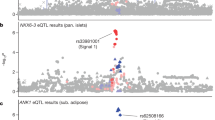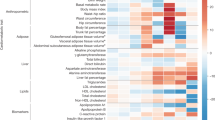Abstract
We conducted a genome-wide association study for type 2 diabetes (T2D) in Icelandic cases and controls, and we found that a previously described variant in the transcription factor 7-like 2 gene (TCF7L2) gene conferred the most significant risk. In addition to confirming two recently identified risk variants1, we identified a variant in the CDKAL1 gene that was associated with T2D in individuals of European ancestry (allele-specific odds ratio (OR) = 1.20 (95% confidence interval, 1.13–1.27), P = 7.7 × 10−9) and individuals from Hong Kong of Han Chinese ancestry (OR = 1.25 (1.11–1.40), P = 0.00018). The genotype OR of this variant suggested that the effect was substantially stronger in homozygous carriers than in heterozygous carriers. The ORs for homozygotes were 1.50 (1.31–1.72) and 1.55 (1.23–1.95) in the European and Hong Kong groups, respectively. The insulin response for homozygotes was approximately 20% lower than for heterozygotes or noncarriers, suggesting that this variant confers risk of T2D through reduced insulin secretion.
This is a preview of subscription content, access via your institution
Access options
Subscribe to this journal
Receive 12 print issues and online access
$209.00 per year
only $17.42 per issue
Buy this article
- Purchase on Springer Link
- Instant access to full article PDF
Prices may be subject to local taxes which are calculated during checkout


Similar content being viewed by others
References
Sladek, R. et al. A genome-wide association study identifies novel risk loci for type 2 diabetes. Nature 445, 881–885 (2007).
Grant, S.F. et al. Variant of transcription factor 7-like 2 (TCF7L2) gene confers risk of type 2 diabetes. Nat. Genet. 38, 320–323 (2006).
Helgason, A. et al. Refining the impact of TCF7L2 gene variants on type 2 diabetes and adaptive evolution. Nat. Genet. 39, 218–225 (2007).
Pe'er, I. et al. Evaluating and improving power in whole-genome association studies using fixed marker sets. Nat. Genet. 38, 663–667 (2006).
Devlin, B. & Roeder, K. Genomic control for association studies. Biometrics 55, 997–1004 (1999).
Skol, A.D., Scott, L.J., Abecasis, G.R. & Boehnke, M. Joint analysis is more efficient than replication-based analysis for two-stage genome-wide association studies. Nat. Genet. 38, 209–213 (2006).
Chimienti, F., Devergnas, S., Favier, A. & Seve, M. Identification and cloning of a beta-cell-specific zinc transporter, ZnT-8, localized into insulin secretory granules. Diabetes 53, 2330–2337 (2004).
Ching, Y.P., Pang, A.S., Lam, W.H., Qi, R.Z. & Wang, J.H. Identification of a neuronal Cdk5 activator-binding protein as Cdk5 inhibitor. J. Biol. Chem. 277, 15237–15240 (2002).
Wei, F.Y. et al. Cdk5-dependent regulation of glucose-stimulated insulin secretion. Nat. Med. 11, 1104–1108 (2005).
Ubeda, M., Rukstalis, J.M. & Habener, J.F. Inhibition of cyclin-dependent kinase 5 activity protects pancreatic beta cells from glucotoxicity. J. Biol. Chem. 281, 28858–28864 (2006).
Reynisdottir, I. et al. Localization of a susceptibility gene for type 2 diabetes to chromosome 5q34-q35.2. Am. J. Hum. Genet. 73, 323–335 (2003).
Tanko, L.B., Bagger, Y.Z., Nielsen, S.B. & Christiansen, C. Does serum cholesterol contribute to vertebral bone loss in postmenopausal women? Bone 32, 8–14 (2003).
Jorgensen, T. et al. A randomized non-pharmacological intervention study for prevention of ischaemic heart disease: baseline results Inter99. Eur. J. Cardiovasc. Prev. Rehabil. 10, 377–386 (2003).
Helgadottir, A. et al. A variant of the gene encoding leukotriene A4 hydrolase confers ethnicity-specific risk of myocardial infarction. Nat. Genet. 38, 68–74 (2006).
Yang, X. et al. Development and validation of stroke risk equation for Hong Kong Chinese patients with type 2 diabetes: the Hong Kong Diabetes Registry. Diabetes Care 30, 65–70 (2007).
Rotimi, C.N. et al. In search of susceptibility genes for type 2 diabetes in West Africa: the design and results of the first phase of the AADM study. Ann. Epidemiol. 11, 51–58 (2001).
Kutyavin, I.V. et al. A novel endonuclease IV post-PCR genotyping system. Nucleic Acids Res. 34, e128 (2006).
Gretarsdottir, S. et al. The gene encoding phosphodiesterase 4D confers risk of ischemic stroke. Nat. Genet. 35, 131–138 (2003).
Rice, J.A. Mathematical Statistics and Data Analysis (Wadsworth, Belmont, California, 1995).
Mantel, N. & Haenszel, W. Statistical aspects of the analysis of data from retrospective studies of disease. J. Natl. Cancer Inst. 22, 719–748 (1959).
Stefansson, H. et al. A common inversion under selection in Europeans. Nat. Genet. 37, 129–137 (2005).
Helgason, A., Yngvadottir, B., Hrafnkelsson, B., Gulcher, J. & Stefansson, K. An Icelandic example of the impact of population structure on association studies. Nat. Genet. 37, 90–95 (2005).
Sluiter, W.J., Erkelens, D.W., Reitsma, W.D. & Doorenbos, H. Glucose tolerance and insulin release, a mathematical approach I. Assay of the beta-cell response after oral glucose loading. Diabetes 25, 241–244 (1976).
Hanson, R.L. et al. Evaluation of simple indices of insulin sensitivity and insulin secretion for use in epidemiologic studies. Am. J. Epidemiol. 151, 190–198 (2000).
Matthews, D.R. et al. Homeostasis model assessment: insulin resistance and beta-cell function from fasting plasma glucose and insulin concentrations in man. Diabetologia 28, 412–419 (1985).
The International HapMap Consortium. A haplotype map of the human genome. Nature 437, 1299–1320 (2005).
Acknowledgements
We thank the individuals with T2D and other study participants whose contribution made this work possible. We also thank the nurses at Noatun (deCODE's sample recruitment center) and personnel at the deCODE core facilities for their hard work and enthusiasm. The Denmark B studies were supported by a grant from Eugene 2. Support for the Africa America Diabetes Mellitus (AADM) study is provided by the US National Institutes of Health, including the National Center on Minority Health and Health Disparities (3T37TW00041-03S2), the National Institute of Diabetes and Digestive and Kidney Diseases (DK072128), the National Human Genome Research Institute and the National Center for Research Resources (RR03048). The Hong Kong Diabetes case-control study was supported by the Hong Kong Research Grants Committee Central Allocation Scheme CUHK 1/04C.
Author information
Authors and Affiliations
Corresponding authors
Ethics declarations
Competing interests
V.S., G.T., I.R., T. Jonsdottir, G.B.W., U.S., S. Gretarsdottir, V.E., S. Ghosh, A.B., S.S., H.B., M.G., J.R.G., U.T., A.K. and K.S. are employees and shareholders of deCODE genetics, Inc.
Supplementary information
Supplementary Fig. 1
A Q-Q plot of the genome-wide association results. (PDF 185 kb)
Supplementary Table 1
Association with T2D in the Icelandic discovery group. (PDF 88 kb)
Supplementary Table 2
Association with T2D in the primary replication group (Denmark B). (PDF 83 kb)
Supplementary Table 3
Association results for SNPs reported to have association with T2D in ref. 1. (PDF 87 kb)
Supplementary Table 4
Association with T2D and pairwise correlation for eight SNPs in CDKAL1. (PDF 146 kb)
Supplementary Table 5
Association with T2D for 61 SNPs in CDKAL1. (PDF 75 kb)
Supplementary Table 6
Association with insulin secretion and insulin sensitivity. (PDF 77 kb)
Supplementary Table 7
Characteristics of the T2D case-control groups. (PDF 68 kb)
Rights and permissions
About this article
Cite this article
Steinthorsdottir, V., Thorleifsson, G., Reynisdottir, I. et al. A variant in CDKAL1 influences insulin response and risk of type 2 diabetes. Nat Genet 39, 770–775 (2007). https://doi.org/10.1038/ng2043
Received:
Accepted:
Published:
Issue Date:
DOI: https://doi.org/10.1038/ng2043
This article is cited by
-
HDL levels modulate the impact of type 2 diabetes susceptibility alleles in older adults
Lipids in Health and Disease (2024)
-
Epitranscriptomics in metabolic disease
Nature Metabolism (2023)
-
The influence of CDKAL1 (rs7754840) gene polymorphism on susceptibility to gestational diabetes mellitus in pregnant women: a systematic review and meta-analysis
International Journal of Diabetes in Developing Countries (2023)
-
Population history modulates the fitness effects of Copy Number Variation in the Roma
Human Genetics (2023)
-
Association between TCF7L2 polymorphism and type 2 diabetes mellitus susceptibility: a case–control study among the Bangladeshi population
Molecular Biology Reports (2023)



